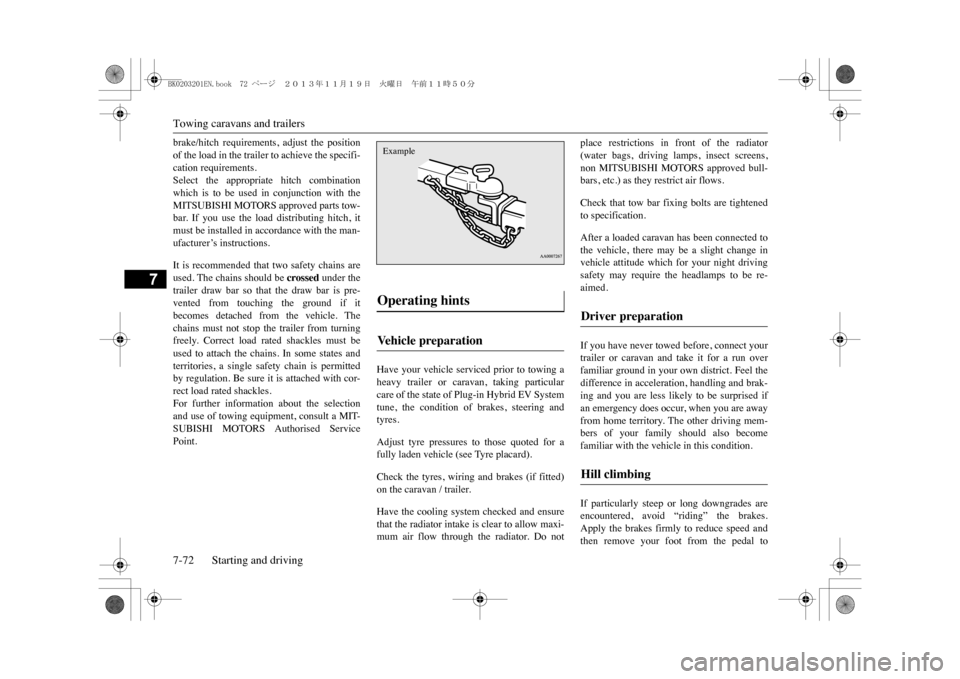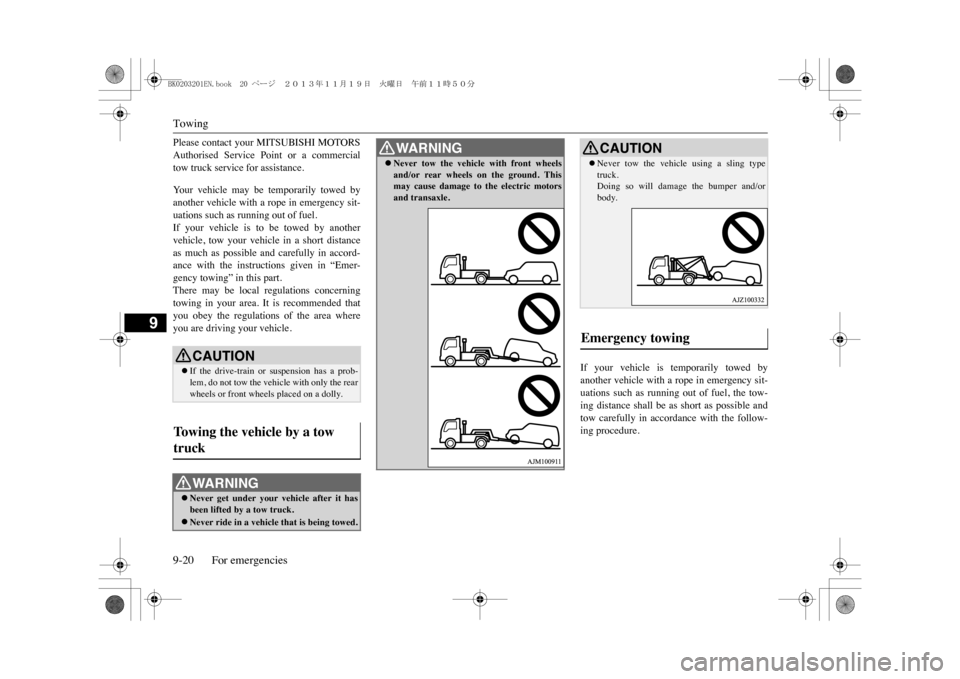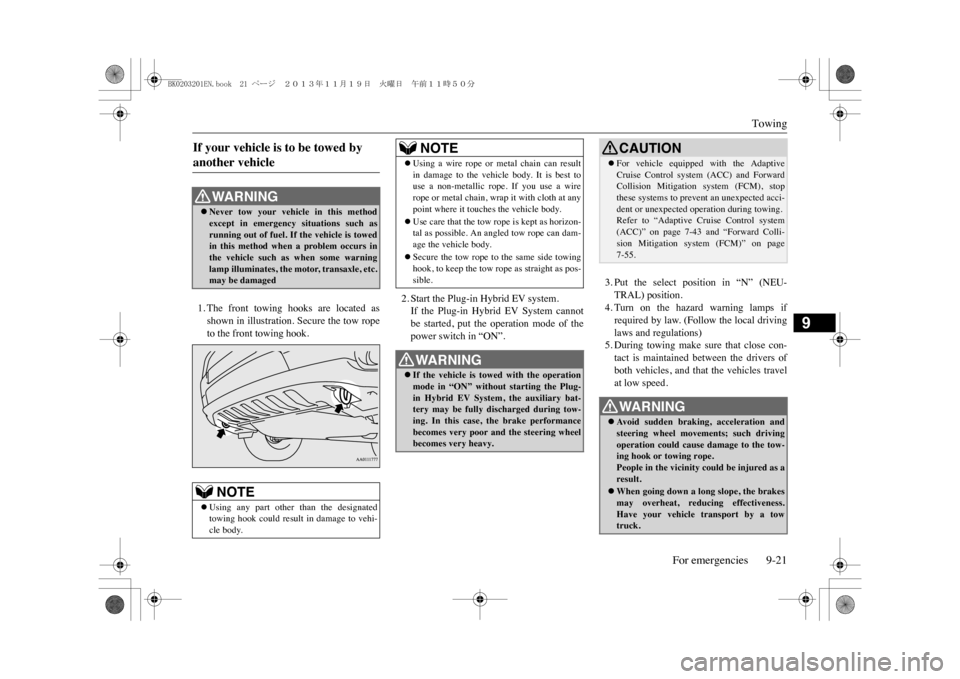2014 MITSUBISHI OUTLANDER SPORT emergency towing
[x] Cancel search: emergency towingPage 15 of 388

Plug-in Hybrid EV System2-6 General information
2
•Open the windows, doors and tailgate.•Put the operation mode in OFF.•Turn on the hazard warning flashers.• Move the key away from the vehicle toprevent unintended start-up of the sys-tem by inadvertent contact with a switchor impact from the crash.
�zNever touch high-voltage wiring, connec-tors, and other high-vol
tage parts, such as
the inverter unit and drive battery. Anelectric shock may occur if exposed elec-tric wires are visible when viewed frominside or outside of
your vehicle. For their
locations, see “High-
voltage components”
on page 2-7.�zIf the vehicle receives a strong impact tothe floor while driving, stop the vehicle ina safe place and
check the floor.
�zNever start the plug-in hybrid EV systemif you found the leak
of a liquid (except
water of the air conditioner) while check-ing the outside of the vehicle because thereis possibility the fuel system has beendamaged and causing of fire or exploding.In such case, immediately contact yourMITSUBISHI MOTORS Authorized Ser-vice Point.WA R N I N G
�zLeaks or damage to the drive battery mayresult in a fire. If you discover them, con-tact emergency services immediately.Since the fluid leak may be lithium man-ganite from the Lithium-ion battery, nevertouch any fluid leaking from the inside oroutside of the vehicle. If the fluid contactsyour skin or eyes, wash
it off immediately
with a large amount of water and receiveimmediate medical attention to help avoidserious injury.�zIf you are unable to safely assess the vehi-cle due to vehicle damage, do not touchthe vehicle. Leave the vehicle and contactemergency services. Advise emergencyresponders that this is a Plug-in Hybridvehicle.�zIf a fire occurs in this vehicle, leave thevehicle as soon as possible and contactemergency services. Do not attempt toextinguish a fire by yourself. If the fireinvolves a lithium-ion battery, it willrequire large, sustained volumes of waterfor extinguishment. Using a small amountof water or the incorrect fire extinguishercan result in serious injury or death fromelectrical shock.�zWhen you leave the vehicle, if possible,open the windows, doors and tailgate toprevent accumulation of poisonous/com-bustible gasses. This will
also assist in the
rescue and fire fighting process.WA R N I N G
�zAs with any vehicle fire, the byproducts ofcombustion can be toxic. Do not inhalesmoke, vapors, or gas from the vehicle.Move to a safe distance upwind and uphillfrom the vehicle fire and out of the way ofany oncoming traffic while awaiting thearrival of emergency responders.�zIf you detect leaking fluids, sparks, smoke,flames, gurgling, popping or hissing noisesoriginating from the high voltage batterycompartment, contact emergency servicesimmediately. This may result in a fire.�zPhysical damage to the vehicle or highvoltage battery may result in immediate ordelayed release of toxic and/or flammablegases and fire.�zIf your vehicle needs to be towed, trans-port the vehicle on a
flatbed truck or tow
the vehicle with all wheels off the ground.If the any wheels are on the ground whentowing, this may cause damage to the elec-tric motors. This may also cause a fire, ifwiring in the electric motor unit roombecomes damaged. Refer to “Towing” onpage 9-19.�zDo not attempt to repair a damaged Plug-in Hybrid vehicle by yourself. Please con-tact a MITSUBISHI MOTORS Author-ised Service Point for service.WA R N I N G
BK0203201EN.book 6 ページ 2013年11月19日 火曜日 午前11時50分
Page 164 of 388

7
Starting and drivingEconomical driving ...........................................................................7-2Driving, alcohol and drugs ...............................................................7-2Floor mat *........................................................................................ 7-3Safe driving techniques..................................................................... 7-4Parking brake .................................................................................... 7-4Parking .............................................................................................. 7-5Steering wheel height and reach adjustment..................................... 7-6Inside rear-view mirror .....................................................................7-6Outside rear-view mirrors .................................................................7-7Power switch ...................................................................................7-10Starting and stopping the Plug-in Hybrid EV System .................... 7-12Selector Lever (Joystick Type) .......................................................7-14Select Position indicator .................................................................7-15Electrical Parking switch ................................................................7-16Regenerative braking level selector (paddle) * ..............................7-17S-AWC (Super All Wheel Control) ................................................7-184-wheel drive operation ..................................................................7-20Inspection and maintenance following rough road operation.........7-21Cautions on the handling of 4-wheel drive vehicles.......................7-22Battery save switch .........................................................................7-22Battery charge switch......................................................................7-23Acoustic Vehicle Alerting System (AVAS) ...................................7-24Braking ...........................................................................................7-26Hill start assist.................................................................................7-27Brake assist system .........................................................................7-28Emergency stop signal system * .....................................................7-29Anti-lock brake system (ABS)........................................................7-29Electric power steering system (EPS).............................................7-32
Active stability control (ASC) ........................................................ 7-32Cruise control * .............................................................................. 7-35Speed Limiter * .............................................................................. 7-39Adaptive Cruise Control System (ACC) * ..................................... 7-43Forward Collision Mitigation System (FCM) * ............................. 7-55Lane Departure Warning (LDW) *................................................. 7-60Reversing sensor system *.............................................................. 7-63Rear-view camera * ........................................................................ 7-67Cargo loads ..................................................................................... 7-70Towing caravans and trailers .......................................................... 7-71
BK0203201EN.book 1 ページ 2013年11月19日 火曜日 午前11時50分
Page 235 of 388

Towing caravans and trailers7-72 Starting and driving
7
brake/hitch requirements, adjust the positionof the load in the trailer to achieve the specifi-cation requirements.Select the appropriate hitch combinationwhich is to be used in conjunction with theMITSUBISHI MOTORS approved parts tow-bar. If you use the load distributing hitch, itmust be installed in accordance with the man-ufacturer’s instructions.It is recommended that two safety chains areused. The chains should be
crossed
under the
trailer draw bar so that the draw bar is pre-vented from touching the ground if itbecomes detached from the vehicle. Thechains must not stop the trailer from turningfreely. Correct load rated shackles must beused to attach the chains. In some states andterritories, a single safety chain is permittedby regulation. Be sure it is attached with cor-rect load rated shackles.For further information about the selectionand use of towing equipment, consult a MIT-SUBISHI MOTORS Authorised ServicePoint.
Have your vehicle serviced prior to towing aheavy trailer or caravan, taking particularcare of the state of Plug-in Hybrid EV Systemtune, the condition of brakes, steering andtyres.Adjust tyre pressures to those quoted for afully laden vehicle (see Tyre placard).Check the tyres, wiring and brakes (if fitted)on the caravan / trailer.Have the cooling system checked and ensurethat the radiator intake is clear to allow maxi-mum air flow through the radiator. Do not
place restrictions in front of the radiator(water bags, driving lamps, insect screens,non MITSUBISHI MOTORS approved bull-bars, etc.) as they restrict air flows.Check that tow bar fixing bolts are tightenedto specification.After a loaded caravan has been connected tothe vehicle, there may be a slight change invehicle attitude which for your night drivingsafety may require the headlamps to be re-aimed.If you have never towed before, connect yourtrailer or caravan and take it for a run overfamiliar ground in your own district. Feel thedifference in acceleration, handling and brak-ing and you are less likely to be surprised ifan emergency does occur, when you are awayfrom home territory. The other driving mem-bers of your family should also becomefamiliar with the vehicle in this condition.If particularly steep or long downgrades areencountered, avoid “riding” the brakes.Apply the brakes firmly to reduce speed andthen remove your foot from the pedal to
Operating hints Ve h i c l e p r e p a r a t i o n Example
Driver preparation Hill climbing
BK0203201EN.book 72 ページ 2013年11月19日 火曜日 午前11時50分
Page 331 of 388

Towing9-20 For emergencies
9
Please contact your MITSUBISHI MOTORSAuthorised Service Point or a commercialtow truck service for assistance.Yo u r v e h i c l e m a y b e t e m p o r a r i l y t o w e d b yanother vehicle with a rope in emergency sit-uations such as running out of fuel.If your vehicle is to be towed by anothervehicle, tow your vehicle in a short distanceas much as possible and carefully in accord-ance with the instructions given in “Emer-gency towing” in this part.There may be local regulations concerningtowing in your area. It is recommended thatyou obey the regulations of the area whereyou are driving your vehicle.
If your vehicle is temporarily towed byanother vehicle with a rope in emergency sit-uations such as running out of fuel, the tow-ing distance shall be as short as possible andtow carefully in accordance with the follow-ing procedure.
CAUTION�zIf the drive-train or suspension has a prob-lem, do not tow the vehicle with only the rearwheels or front wheels placed on a dolly.
To w i n g t h e v e h i c l e b y a t o w truck
WA R N I N G�zNever get under your vehicle after it hasbeen lifted by a tow truck.�zNever ride in a vehicle that is being towed.
�zNever tow the vehicle with front wheelsand/or rear wheels on the ground. Thismay cause damage to the electric motorsand transaxle.WA R N I N G
CAUTION�zNever tow the vehicl
e using a sling type
truck.Doing so will damage the bumper and/orbody.
Emergency towing
BK0203201EN.book 20 ページ 2013年11月19日 火曜日 午前11時50分
Page 332 of 388

Towing
For emergencies 9-21
9
1. The front towing hooks are located asshown in illustration. Secure the tow ropeto the front towing hook.
2. Start the Plug-in Hybrid EV system.If the Plug-in Hybrid EV System cannotbe started, put the operation mode of thepower switch in “ON”.
3. Put the select position in “N” (NEU-TRAL) position.4. Turn on the hazard warning lamps ifrequired by law. (Follow the local drivinglaws and regulations)5. During towing make sure that close con-tact is maintained between the drivers ofboth vehicles, and that the vehicles travelat low speed.
If your vehicle is to be towed by another vehicle
WA R N I N G�zNever tow your vehicle in this methodexcept in emergency situations such asrunning out of fuel. If
the vehicle is towed
in this method when
a problem occurs in
the vehicle such as when some warninglamp illuminates, the motor, transaxle, etc.may be damagedNOTE
�zUsing any part other than the designatedtowing hook could result in
damage to vehi-
cle body.
�zUsing a wire rope or metal chain can resultin damage to the vehicle body. It is best touse a non-metallic rope. If you use a wirerope or metal chain, wrap it with cloth at anypoint where it touches the vehicle body.�zUse care that the tow rope is kept as horizon-tal as possible. An angled tow rope can dam-age the vehicle body.�zSecure the tow rope to the same side towinghook, to keep the tow rope
as straight as pos-
sible.WA R N I N G�zIf the vehicle is towed with the operationmode in “ON” withou
t starting the Plug-
in Hybrid EV System, the auxiliary bat-tery may be fully discharged during tow-ing. In this case, the brake performancebecomes very poor and the steering wheelbecomes very heavy.NOTE
CAUTION�zFor vehicle equipped with the AdaptiveCruise Control system (ACC) and ForwardCollision Mitigation system (FCM), stopthese systems to prevent an unexpected acci-dent or unexpected op
eration during towing.
Refer to “Adaptive Cruise Control system(ACC)” on page 7-43 and “Forward Colli-sion Mitigation system (FCM)” on page7-55.WA R N I N G�zAv o i d s u d d e n b r a k i n g ,
acceleration and
steering wheel movements; such drivingoperation could cause damage to the tow-ing hook or towing rope.People in the vicinity could be injured as aresult.�zWhen going down a long slope, the brakesmay overheat, reducing effectiveness.Have your vehicle transport by a towtruck.
BK0203201EN.book 21 ページ 2013年11月19日 火曜日 午前11時50分